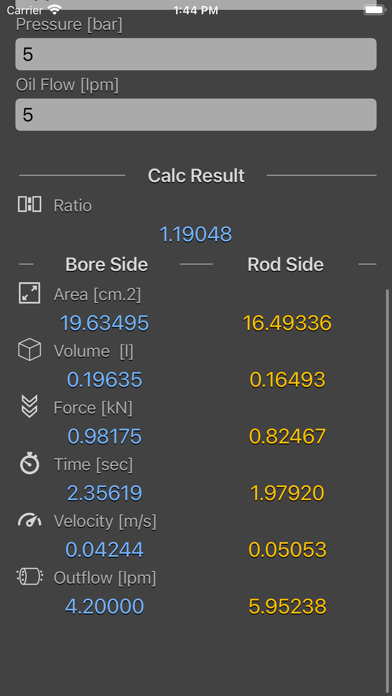
Hydraulic Cylinder Calc app for iPhone and iPad
Developer: Nitrio
First release : 30 Mar 2018
App size: 10.14 Mb
The Hydraulic Cylinder Calculator is a comprehensive tool designed for working with hydraulic cylinders. Users can input parameters such as piston diameter, pressure, and oil flow to calculate various aspects of the cylinder, including areas, volumes, ratio, extraction and retraction forces, velocity, time, and outflow.
Features:
- On-the-fly calculations based on user-input parameters like piston diameter, pressure, and oil flow.
- Results are provided for both the Piston and Rod sides of the Hydraulic Cylinder.
- Interactive 3D images illustrate key parameters, enhancing the users understanding of the Hydraulic Cylinder system.
- Support for both Metric and Imperial units.
- Copy-able results to clipboard.
A hydraulic cylinder, also known as a linear hydraulic motor, is a mechanical actuator used to provide a unidirectional force through a unidirectional stroke. It finds applications in construction equipment (engineering vehicles), manufacturing machinery, and civil engineering.
Hydraulic cylinders are powered by pressurized hydraulic fluid, typically oil. The cylinder comprises a cylinder barrel, a piston connected to a piston rod that moves back and forth. The barrel is closed by the cylinder bottom (cap) on one end and the cylinder head (gland) on the other end, where the piston rod emerges. The piston has sliding rings and seals, dividing the cylinder into two chambers – the bottom chamber (cap end) and the piston rod side chamber (rod end/head end).
Flanges, trunnions, clevises, and lugs are common mounting options for cylinders. The piston rod also has attachments for connecting the cylinder to the object or machine component it pushes or pulls.
The hydraulic cylinder acts as the actuator or "motor" side of the system, while the hydraulic pump serves as the "generator" side, delivering a fixed or regulated oil flow to move the piston. The piston, in turn, pushes the oil in the opposite chamber back to the reservoir. During the extension stroke, assuming the oil enters from the cap end and the oil pressure in the rod end/head end is approximately zero, the force (F) on the piston rod equals the pressure (P) in the cylinder times the piston area (A).
Thanks for your support, and please visit nitrio.com for more apps for your iOS devices.



